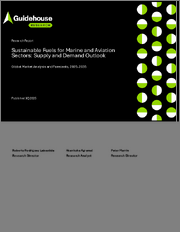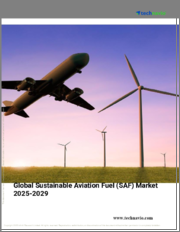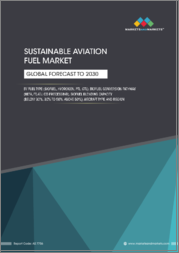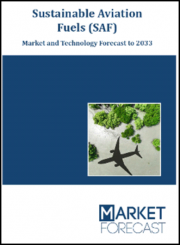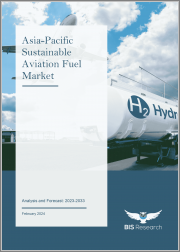
|
시장보고서
상품코드
1422243
아시아태평양의 지속가능 항공연료 시장 : 분석과 예측(2023-2033년)Asia-Pacific Sustainable Aviation Fuel Market: Analysis and Forecast, 2023-2033 |
||||||
아시아태평양의 지속가능 항공연료 시장 규모는 2023년 3억 8,000만 달러에서 2033년에는 392억 3,000만 달러에 달하며, 예측 기간인 2023-2033년의 성장률은 58.99%에 달할 것으로 예측되고 있습니다.
이 분야의 성장은 지속가능 항공연료(SAF)의 생산 능력 향상, 공급망 관리의 효율화, 비용 저감으로 연결되는 최첨단 기술과 협력 관계에 의해 추진됩니다.
| 주요 시장 통계 | |
|---|---|
| 예측 기간 | 2023-2033년 |
| 2023년 평가 | 3억 8,000만 달러 |
| 2033년 예측 | 392억 3,000만 달러 |
| CAGR | 58.99% |
아시아태평양에서는 지속가능 항공연료(SAF)에 대한 채택과 관심이 크게 증가하고 있습니다. 기존 항공 연료를 대체할 수 있는 청정 연료를 찾는 세계적인 추세는 기후 변화 및 항공 산업이 생태계에 미치는 영향과 관련된 환경 문제 증가와 맞물려 있습니다. 바이오매스, 폐식용유, 수소 등 지속가능한 자원에서 추출한 SAF는 이러한 문제에 대한 실행 가능한 해결책을 제시합니다. 아시아태평양의 SAF 시장은 첨단 기술과 전략적 파트너십의 결합을 통해 괄목할 만한 성장세를 보이고 있습니다. 이러한 움직임은 SAF의 제조 능력을 향상시키고, 공급망 물류를 간소화하며, 제조 비용을 낮추는 데 기여하고 있습니다. 그러나 SAF가 잠재력을 최대한 발휘하고 아시아태평양 항공 여행의 지속가능한 미래에 기여하기 위해서는 몇 가지 중요한 과제를 해결해야 합니다. 여기에는 생산 규모 확대, 안정적인 원자재 공급 확보, SAF 채택을 지원하고 인센티브를 제공하는 강력한 규제 프레임워크 구축 등이 포함됩니다.
아시아태평양의 지속가능 항공연료 시장에 대해 조사했으며, 시장의 개요와 용도별, 연료 유형별, 제조 기술별, 국가별 동향 및 시장에 참여하는 기업의 개요 등을 제공하고 있습니다.
목차
주요 요약
조사 범위
제1장 시장
- 업계의 전망
- 비즈니스 역학
제2장 지역
- 지속가능 항공연료 시장(지역별)
- 아시아태평양
- 시장
- 용도
- 제품
- 아시아태평양(국가별)
제3장 시장 - 경쟁 벤치마킹과 기업 개요
- 경쟁 벤치마킹
- 기업 개요
제4장 조사 방법
KSA 24.02.19“The Asia-Pacific Sustainable Aviation Fuel Market Expected to Reach $39.23 Billion by 2033.”
Introduction to Asia-Pacific Sustainable Aviation Fuel Market
The Asia-Pacific sustainable aviation fuel market is estimated to reach $39.23 billion by 2033 from $0.38 billion in 2023, at a growth rate of 58.99% during the forecast period 2023-2033. Growth in the sector is propelled by state-of-the-art technology and collaborations, leading to increased production capacity for Sustainable Aviation Fuel (SAF), enhanced efficiency in supply chain management, and lowered costs.
| KEY MARKET STATISTICS | |
|---|---|
| Forecast Period | 2023 - 2033 |
| 2023 Evaluation | $0.38 Billion |
| 2033 Forecast | $39.23 Billion |
| CAGR | 58.99% |
Market Introduction
The Asia-Pacific (APAC) region is witnessing a significant surge in the adoption and interest in Sustainable Aviation Fuel (SAF). This global trend towards cleaner alternatives to traditional aviation fuels aligns with the growing environmental concerns related to climate change and the ecological impact of the aviation industry. SAF, derived from sustainable sources such as biomass, used cooking oil, or hydrogen, offers a viable solution to these challenges. The APAC SAF market is experiencing notable growth, driven by the convergence of cutting-edge technologies and strategic partnerships. These developments are enhancing SAF manufacturing capabilities, streamlining supply chain logistics, and driving down production costs. However, for SAF to achieve its full potential and contribute to a more sustainable future for air travel in the APAC region, critical issues must be addressed. These include scaling up production, ensuring a consistent supply of feedstock, and establishing robust regulatory frameworks to support and incentivize the adoption of SAF.
Market Segmentation:
Segmentation 1: by Application
- Commercial Aviation
- Business and General Aviation
- Military Aviation
- Unmanned Aerial Vehicle (UAV)
Segmentation 2: by Fuel Type
- Hydrogen Fuel
- Biofuel
- Power-to-Liquid Fuel
- Gas-to-Liquid Fuel
Segmentation 3: by Manufacturing Technology
- Fischer-Tropsch Synthetic Paraffinic Kerosene (FT-SPK)
- Hydroprocessed Esters and Fatty Acids-Synthetic Paraffinic Kerosene (HEFA-SPK)
- Alcohol-to-Jet Synthetic Paraffinic Kerosene (ATJ-SPK)
- Synthetic ISO-Paraffin from Fermented Hydroprocessed Sugar (HFS-SIP)
- Catalytic Hydrothermolysis Jet (CHJ)
Segmentation 4: by Country
- Japan
- India
- China
- Rest-of-Asia-Pacific
How can this report add value to an organization?
Product/Innovation Strategy: The product segment helps the reader understand the different types of products available for deployment and their potential. Moreover, the study provides the reader with a detailed understanding of the sustainable aviation fuel market by application (commercial aviation, business and general aviation, military aviation and unmanned aerial vehicle (UAV), product on the basis of fuel type (hydrogen fuel, biofuel, power-to-liquid fuel, and gas-to-liquid fuel), manufacturing technology (fischer-tropsch synthetic paraffinic kerosene (FT-SPK), hydroprocessed esters and fatty acids-synthetic paraffinic kerosene (HEFA-SPK), alcohol-to-jet synthetic paraffinic kerosene (ATJ-SPK), synthetic ISO-paraffin from fermented hydroprocessed sugar (HFS-SIP), and catalytic hydrothermolysis jet (CHJ).
Growth/Marketing Strategy: The sustainable aviation fuel market has seen major development by key players operating in the market, such as business expansion, partnership, collaboration, and joint venture. The favored strategy for the companies has been merger and acquisition to strengthen their position in the sustainable aviation fuel market.
Competitive Strategy: Key players in the APAC sustainable aviation fuel market analyzed and profiled in the study involve major sustainable aviation fuel offering companies providing sustainable aviation fuel and different manufacturing technology. Moreover, a detailed competitive benchmarking of the players operating in the sustainable aviation fuel market has been done to help the reader understand how players stack against each other, presenting a clear market landscape. Additionally, comprehensive competitive strategies such as partnerships, agreements, and collaborations will aid the reader in understanding the untapped revenue pockets in the market.
Table of Contents
Executive Summary
Scope of the Study
1. Markets
- 1.1. Industry Outlook
- 1.1.1. Sustainable Aviation Fuel Market: Overview
- 1.1.2. Evolving Emission Control Measures in the Aviation Industry
- 1.1.3. Emerging Zero Emissions Aircraft Technology
- 1.1.3.1. Electric Propulsion Systems
- 1.1.3.2. Hydrogen Fuel Cell Technology
- 1.1.3.3. Advanced Aerodynamics and Lightweight Materials
- 1.1.3.4. Urban Air Mobility (UAM) and Electric Vertical Take-Off and Landing (eVTOL)
- 1.1.4. Current and Future Technological Trends
- 1.1.4.1. Carbon Capture and Utilization (CCU) Technologies
- 1.1.4.2. Direct Air Capture (DAC) Technologies
- 1.1.5. Evolving Aviation Propulsion Technologies: Migration Toward Reduced Emissions
- 1.1.6. Critical Success Parameters for Sustainable Aviation Fuel Adoption
- 1.2. Business Dynamics
- 1.2.1. Business Drivers
- 1.2.1.1. Increasing Environmental Concerns
- 1.2.1.2. Volatile Jet Fuel Prices
- 1.2.1.3. Advances in Conversion Technologies
- 1.2.2. Business Challenges
- 1.2.2.1. Infrastructure Development Cost
- 1.2.2.2. Certification and Sustainability Criteria
- 1.2.2.3. Inadequate Supply of Feedstock
- 1.2.3. Business Opportunities
- 1.2.3.1. SAF Offtake Agreements
- 1.2.4. Business Strategies
- 1.2.4.1. Market Developments
- 1.2.4.2. Partnerships, Collaborations, Agreements, and Contracts
- 1.2.1. Business Drivers
2. Region
- 2.1. Sustainable Aviation Fuel Market (by Region)
- 2.2. Asia-Pacific
- 2.2.1. Market
- 2.2.1.1. Key Players in Asia-Pacific
- 2.2.1.2. Business Drivers
- 2.2.1.3. Business Challenges
- 2.2.2. Application
- 2.2.2.1. Asia-Pacific Sustainable Aviation Fuel Market (by Application)
- 2.2.3. Product
- 2.2.3.1. Asia-Pacific Sustainable Aviation Fuel Market (by Fuel Type)
- 2.2.3.2. Asia-Pacific Sustainable Aviation Fuel Market (by Manufacturing Technology)
- 2.2.4. Asia-Pacific (by Country)
- 2.2.4.1. China
- 2.2.4.1.1. Market
- 2.2.4.1.1.1. Key Players in China
- 2.2.4.1.2. Application
- 2.2.4.1.2.1. China Sustainable Aviation Fuel Market (by Application)
- 2.2.4.1.3. Product
- 2.2.4.1.3.1. China Sustainable Aviation Fuel Market (by Fuel Type)
- 2.2.4.1.1. Market
- 2.2.4.2. India
- 2.2.4.2.1. Market
- 2.2.4.2.1.1. Key Players in India
- 2.2.4.2.2. Application
- 2.2.4.2.2.1. India Sustainable Aviation Fuel Market (by Application)
- 2.2.4.2.3. Product
- 2.2.4.2.3.1. India Sustainable Aviation Fuel Market (by Fuel Type)
- 2.2.4.2.1. Market
- 2.2.4.3. Japan
- 2.2.4.3.1. Market
- 2.2.4.3.1.1. Key Players in Japan
- 2.2.4.3.2. Application
- 2.2.4.3.2.1. Japan Sustainable Aviation Fuel Market (by Application)
- 2.2.4.3.3. Product
- 2.2.4.3.3.1. Japan Sustainable Aviation Fuel Market (by Fuel Type)
- 2.2.4.3.1. Market
- 2.2.4.4. Rest-of-Asia-Pacific
- 2.2.4.4.1. Market
- 2.2.4.4.1.1. Key Players in Rest-of-Asia-Pacific
- 2.2.4.4.2. Application
- 2.2.4.4.2.1. Rest-of-Asia-Pacific Sustainable Aviation Fuel Market (by Application)
- 2.2.4.4.3. Product
- 2.2.4.4.3.1. Rest-of-Asia-Pacific Sustainable Aviation Fuel Market (by Fuel Type)
- 2.2.4.4.1. Market
- 2.2.4.1. China
- 2.2.1. Market
3. Markets - Competitive Benchmarking & Company Profiles
- 3.1. Competitive Benchmarking
- 3.2. Company Profiles
4. Research Methodology
- 4.1. Factors for Data Prediction and Modeling






